Heat pumps for home heating: principle of operation, heat
What is it - a heat pump? How does he work? Where can these devices extract heat? Finally, how profitable and practical are they compared to other sources of thermal energy? Let's figure it out.
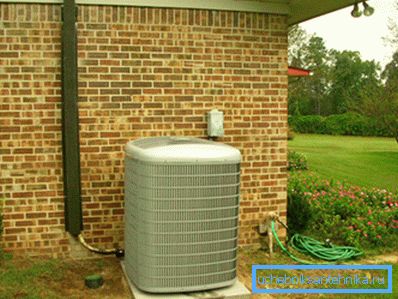
What it is
The principle of operation of the heat pump is completely identical to the operation scheme of an ordinary refrigerator.
- Compressor compresses volatile refrigerant. This produces a significant amount of heat, which is given to the heat exchanger. This heat can be used to heat the air blown through the heat exchanger by the fan, or any heat carrier.
- The cooled refrigerant passes through the expansion valve and increases dramatically in volume.. At the same time, in full accordance with the laws of physics, it is rapidly cooled and, passing through the second heat exchanger, takes heat from its environment.
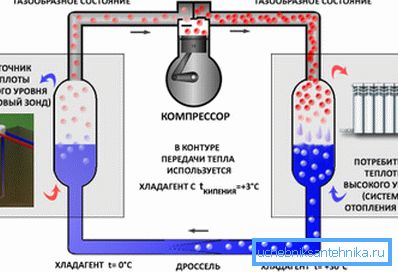
Note: the greater the degree of expansion of the refrigerant, the lower its final temperature. Accordingly, under certain conditions, it is quite capable of extracting heat from a medium cooled well below the freezing point of water.
If the refrigerator is able to work in only one way - for cooling the internal space, then any heat pump for heating the house is able to invert the direction of movement of the refrigerant. On the practical side, this means that the owner of such a device has at its disposal a full-fledged air conditioner: in the winter it heats the room, but in the summer it is used to cool the cottage to a comfortable temperature.
Finally, heat pump heating has another very nice feature. Since electric power is spent only on the operation of the compressor, and the external environment is used as a source of heat, the pump gives between 3 and 5 kilowatts of thermal power for every kilowatt of electric power consumed.

Heat sources
What can be a source of low-grade heat?
Priming
As is known, in the winter cold the soil freezes to a rather insignificant depth. Only a meter below the freezing level, the soil temperature is stable and is 8-12 degrees at any time of the year.
Ground source heat pumps use geothermal heat.
There are two types of heat exchangers:
- Vertical is a long flexible pipes, immersed in vertical wells to a depth of 60-100 meters. Taking into account the fact that the cost of drilling a running meter of a well is 2-3 thousand rubles, the installation of heat exchangers costs a considerable amount; but the vertical heat exchanger does not take place on the site.
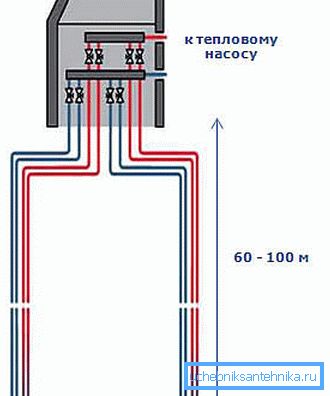
- Horizontal, on the contrary, keeps within shallow depth. Trenches under it can be dug their own hands, without the involvement of technology; accordingly, the installation will be much cheaper. However, the entire area of the soil above the collector (it is about three times the heated area of the house) will be unsuitable for planting: most of the plants will not tolerate overheating of the roots in summer.
The estimated cost of a geothermal heat pump with a heat output of 20 KW is about half a million rubles. Installation depending on the conditions (number and depth of wells, the presence or absence of groundwater, etc.) will force the buyer to spend another 100 - 400 thousand.
Water
If your house is on the bank of a non-freezing reservoir - you are lucky: in this case, heating with heat pumps can be implemented with minimal installation costs. The heat exchanger is heated by weights and removes heat from the water.
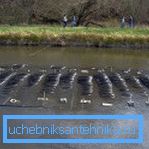
Pumps that use groundwater as a heat source are somewhat more complicated. In this case, two wells are drilled in the area, one of which becomes a source of water, and the second is used to discharge it after passing through the heat exchanger. Approximate flow rate of the well, ensuring the operation of the device with a thermal capacity of 16 KW - 0.8 m3 / hour.
Air
Finally, the cheapest heat pumps that use ambient air as a source of heat. The simplicity of the design makes them relatively inexpensive; installation is also more than simple.
On sale you can find devices operating in two schemes.
- Air-to-air pumps are used only to heat or cool indoor air.
- The air-to-water scheme allows, in addition to heating, to provide the house with hot water.
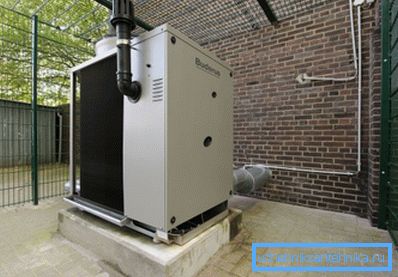
As an example, we present the current retail prices for several devices operating according to the second scheme.
| Model | Thermal power, KW | Cost, rubles |
| AVH-12V1DB | 5.27 | 119700 |
| AVH-24V1DB | 9.0 | 171800 |
| AVH-36V1DB | 13.0 | 336200 |
| AVH-48V1DB | 14.5 | 361200 |
And what about air-to-air pumps? Oh, here the picture is much more attractive. The simplest heat pump of this type - an ordinary window air conditioner - can be bought for 4-5 thousand rubles; A more meaningful purchase - an inverter split system - will cost 20-40 thousand.
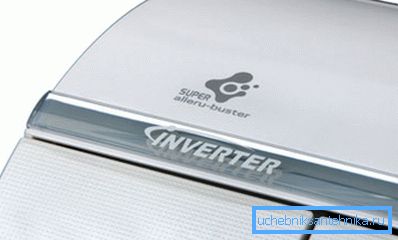
Why at this price ratio do devices that extract heat from water and soil retain their popularity? The answer is simple: air pumps remain operable only at relatively high outdoor temperatures (up to -25 C); meanwhile, in most parts of the country at the peak of winter frosts, the thermometer drops noticeably lower.
Moreover, the lower the street temperature, the less advantageous is the heating of the house by a heat pump of this type. There is such a thing as COP (coefficient of performance), meaning the ratio of heat generated to the cost of electricity. So, this basic characteristic of heat pumps for the very popular Mitsubishi Zubadan is 4.0 at + 5 ° C and 2.0 at-25.
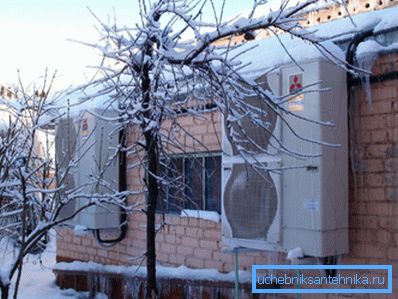
The conclusion is obvious. Heating of a country house with a heat pump operating according to the air-to-air scheme is justified only in a warm climate zone. In Yakutia or Khabarovsk Territory, geothermal devices should be preferred.
Cost effectiveness
Heating a private house with electric heating convectors, fan heaters and other heating devices is the most expensive among all existing schemes. Judge for yourself:
| Heat source | Cost per kilowatt-hour, rubles |
| Main gas | 0.7 |
| Firewood | 1.1 |
| Coal | 1,3 |
| Liquefied gas from a gasholder | 1.8 |
| Liquefied gas from cylinders | 2.8 |
| Diesel fuel | 3.2 |
| Electricity | 3.6 |
However, if you use not direct heating, but a heat pump - heating will become noticeably cheaper. How much - depends on the already mentioned COP. For most models of devices of different types, this parameter falls in the range of 3-4; the best samples have a COP of 6.
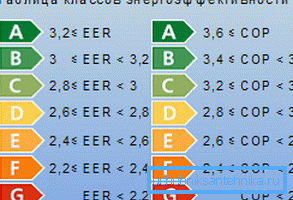
It is worth considering a few more nuances.
- As already mentioned, with air pumps, energy efficiency decreases as the temperature drops outside, so for an estimate it would be correct to take the average value per season (COP for average winter temperature).
- COP depends not only on the temperature of a low-grade heat source, but also on the temperature of the object to which this heat is transferred. The heat pump is precisely the temperature delta. For example, a geothermal pump, heating a warm floor up to + 30C, will be much more economical than giving the same heat to radiators with a temperature of +60.

Practical consequence: if you intend to connect heat pumps for heating your hands to the heating circuit with radiators, note that the number of sections should be increased and the temperature of the heat carrier should be reduced to +40 - +45 C.
Taking into account all the numerous reservations, the average COP value can be safely taken equal to 3.0. In this case, as it is easy to calculate, the cost of a kilowatt-hour of heat will be 1.2 rubles, which is only slightly more expensive than main gas, firewood and cheaper than all other sources of heat.
When choosing heating, it is worth considering not only the current state of affairs, but also prospects. And they are: thanks to the emerging development of green energy (using renewable sources), the cost of electricity will grow much slower than the cost of gas, coal and petroleum products.
In particular, the price growth forecast made in 2010 foreshadows an increase in the cost of a cubic meter of gas by 1000 per cent by 2032, and only 130 per cent of electricity.
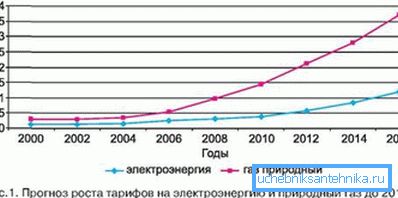
From the author
Perhaps the reader will find the author’s own experience interesting. He uses a pair of air-to-air pumps for home heating.
So, given:
- Place actions - Sevastopol, Crimea. The average January temperature is +3. The present winter was unusually cold: for a couple of days the frost kept at -20 degrees.
- The area of the heated attic is 60 square meters. The gables are a complete glazing with energy-saving single-chamber double-glazed windows. Thermal insulation of the walls and roof is 5 centimeters of mineral wool and foam plastic.
- Cooper acts as a heat source.&Hunter CH-S12 FTXN. Thermal power when working on heating - 4.12 kW, COP is 4.2, the declared lower limit of the working temperature is -25 ° C; the cost at the time of purchase is 24,000 rubles.
Results:
- Throughout the winter, quite comfortable +20 degrees were maintained in the attic.
- Approximate electricity consumption for attic heating was 400 KW-hours. Consumption is easy to convert to a cash equivalent based on local tariffs.
The only problem revealed by the heat pump heating at low temperatures is the freezing of ice in the drainage tube. To eliminate it, it is planned to simply put a section of self-regulating heating cable into the drainage.
Conclusion
Is it worth it to invest in a yet unaccustomed heating system with heat pumps? From the point of view of the author, yes. It looks very attractive even against the background of the main gas - only because it is absolutely safe and does not require removal of combustion products.
However, let the reader make a choice independently. As always, additional thematic information can be found in the attached video. Successes!